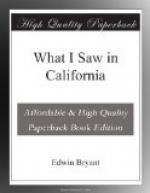A carretada of fossil oyster—shells was shown to me by Mr. Livermore, which had been hauled for the purpose of being manufactured into lime. Some of these shells were eight inches in length, and of corresponding breadth and thickness. They were dug from a hill two or three miles distant, which is composed almost entirely of this fossil. Several bones belonging to the skeleton of a whale, discovered by Mr. L. on the summit of one of the highest elevations in the vicinity of his residence, were shown to me. The skeleton when discovered was nearly perfect and entirely exposed, and its elevation above the level of the sea between one and two thousand feet. How the huge aquatic monster, of which this skeleton is the remains, managed to make his dry bed on the summit of an elevated mountain, more experienced geologists than myself will hereafter determine. I have an opinion on the subject, however; but it is so contrary in some respects to the received geological theories, that I will not now hazard it.
Leaving Mr. Livermore’s about nine o’clock A.M., we travelled three or four miles over a level plain, upon which immense herds of cattle were grazing. When we approached, they fled from us with as much alarm as herds of deer and elk. From this plain we entered a hilly country, covered to the summits of the elevations with wild oats and tufts or hunches of a species of grass, which remains green through the whole season. Cattle were scattered through these hills, and more sumptuous grazing they could not desire. Small streams of water, fed by springs, flow through the hollows and ravines, which, as well as the hill-sides, are timbered with the evergreen oak and a variety of smaller trees. About two o’clock, P.M., we crossed an arroyo which runs through a narrow gorge of the hills, and struck an artificial wagon-road, excavated and embanked so as to afford a passage for wheeled vehicles along the steep hill-side. A little farther on we crossed a very rudely constructed bridge. These are the first signs of road-making I have seen in the country. Emerging from the hills, the southern arm of the Bay of San Francisco came in view, separated from us by a broad and fertile plain, some ten or twelve miles in width, sloping gradually down to the shore of the bay, and watered by several small creeks and estuaries.




